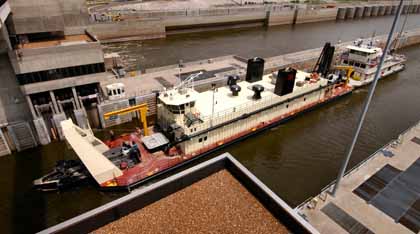 The U.S. Army Corps of Engineers, St. Paul District, celebrated the arrival of the Dredge WILLIAM L. GOETZ, with a christening ceremony June 24, 2005 at the Winona Levee Park, in Winona, Minn.
The U.S. Army Corps of Engineers, St. Paul District, celebrated the arrival of the Dredge WILLIAM L. GOETZ, with a christening ceremony June 24, 2005 at the Winona Levee Park, in Winona, Minn.
The Dredge Goetz:
- 225 feet long by 39 feet wide and eight feet deep, with a five-foot draft;
- 22-inch diameter suction pipe with a 20-inch diameter discharge-pipe;
- 4,010 total installed horsepower;
- not self-propelled, like the Dredge Thompson;
- No quarter/berthing facilities, like the Thompson. The St. Paul District recieved a new towboat, the Motor Vessel General Warren in 2006, and the Quarters Barge Taggatz in 2008.
Q&As
Q1: Why replace the Dredge Thompson?
A1: The Dredge Thompson is worn out and has long outlived its projected life of 50 years. Plus, the Dredge Goetz makes use of new and innovative technology to make dredging safer, more efficient and better for the environment.
Q2: What will happen to the Dredge Thompson?
A2: It was donated to a private group in the summer of 2012.
Q3: How much does the new dredge fleet cost?
A3: The dredge cost was $9.8 million, the towboat cost was $5.6 million and the quarters boat had an estimated cost of $10 million.
Q4: How long is the Dredge Goetz expected to last?
A4: The Goetz is expected to last 40 years but will probably last much longer.
Q5: What makes the Dredge Goetz better for the environment than the Thompson?
A5: There are virtually no hydraulic systems onboard that could leak into the river. Additionally, AC motors driven by Catepillar 3516B engines (and driven at a very low 1,200-rpm speed) will power all the dredge pumps, winches, spud carriage and hoist. This should result in using less fuel and a longer engine life.
Q6: What will the Dredge Goetz do?
A6: The Dredge Goetz will be used to maintain 850 miles of the Upper Mississippi River, 355 miles of the Illinois River and 24 miles of the St. Croix River.
Q7: Why does the Corps have to dredge the river?
A7: Sedimentation in the channel is caused by the normal cycle of silt movement, erosion from high water or heavy rains and changes in river currents. To maintain the 9-foot channel, this material must be removed. The dredged material is used for upland habitat development, wetland creation, aquatic habitat enhancement, beach nourishment, winter road maintenance, levee repair and general-purpose fill.